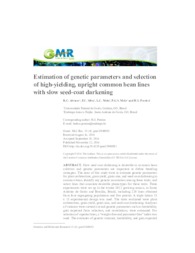Estimation of genetic parameters and selection of high-yielding, upright common bean lines with slow seed-coat darkening.
Estimation of genetic parameters and selection of high-yielding, upright common bean lines with slow seed-coat darkening.
Autoria: ALVARES, R. C.; SILVA, F. C.; MELO, L. C.; MELO, P. G. S.; PEREIRA, H. S.
Resumo: Slow seed coat darkening is desirable in common bean cultivars and genetic parameters are important to define breeding strategies. The aims of this study were to estimate genetic parameters for plant architecture, grain yield, grain size, and seed-coat darkening in common bean; identify any genetic association among these traits; and select lines that associate desirable phenotypes for these traits. Three experiments were set up in the winter 2012 growing season, in Santo Antônio de Goiás and Brasília, Brazil, including 220 lines obtained from four segregating populations and five parents. A triple lattice 15 x 15 experimental design was used. The traits evaluated were plant architecture, grain yield, grain size, and seed-coat darkening. Analyses of variance were carried out and genetic parameters such as heritability, gain expected from selection, and correlations, were estimated. For selection of superior lines, a ?weight-free and parameter-free? index was used. The estimates of genetic variance, heritability, and gain expected from selection were high, indicating good possibility for success in selection of the four traits. The genotype x environment interaction was proportionally more important for yield than for the other traits. There was no strong genetic correlation observed among the four traits, which indicates the possibility of selection of superior lines with many traits. Considering simultaneous selection, it was not possible to join high genetic gains for the four traits. Forty-four lines that combined high yield, more upright plant architecture, slow darkening grains, and commercial grade size were selected.
Ano de publicação: 2016
Tipo de publicação: Artigo de periódico
Unidade: Embrapa Arroz e Feijão
Palavras-chave: Feijão, Hereditariedade, Melhoramento genético vegetal, Parâmetro genético, Phaseolus vulgaris, Seleção
Observações
1 - Por padrão são exibidas publicações dos últimos 20 anos. Para encontrar publicações mais antigas, configure o filtro ano de publicação, colocando o ano a partir do qual você deseja encontrar publicações. O filtro está na coluna da esquerda na busca acima.
2 - Para ler algumas publicações da Embrapa (apenas as que estão em formato ePub), é necessário ter, no celular ou computador, um desses softwares gratuitos. Sistemas Android: Google Play Livros; IOS: iBooks; Windows e Linux: software Calibre.
Acesse outras publicações
Acesse a Base de Dados da Pesquisa Agropecuária (BDPA) para consultar o acervo completo das bibliotecas da Embrapa.

